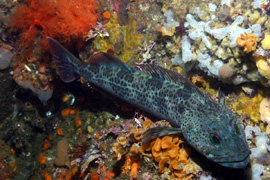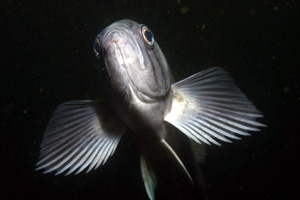Marine Protected Area (MPA) is a broad term for a clearly defined geographical space, recognized, dedicated and managed, through legal or other effective means, to achieve the long term conservation of nature with associated ecosystem services and cultural values. MPAs manage human activities that can result in the removal or alteration of biotic and abiotic components of an ecosystem. Activities curtailed within a MPA may include:
- Extraction of organisms (e.g., commercial and/or recreational harvesting or collecting)
- Mariculture
- Alterations to oceanographic or geologic attributes of the habitat (e.g., mining, shore-based industrial-related intake, discharges of seawater, effluent)
Usually, MPAs are established to conserve biodiversity or enhance nearby fishery resources. Thus, goals and objectives of MPAs can be inferred, even if they are not specifically articulated at the time of reserve formation.
Central California MPAs
On September 21, 2007, after one of the most intensive public processes in ocean governance, 29 new MPAs (204 square miles) went into effect on the Central California Coast; including 9 no-take State Marine Reserves (SMRs) within Monterey Bay National Marine Sanctuary. Prior to 2007, only three no-take marine reserves existed in the MBNMS: Hopkins Marine Life Refuge, Point Lobos Ecological Reserve, and Big Creek Ecological Reserve. In 2007, all 3 SMRs were expanded and renamed; and 6 additional SMRs were established within MBNMS, which is itself a federal MPA. To take a virtual tour of the MPAs, check out the Central Coast MPA Tours tool on Google Earth.
California’s coast and ocean are among our most treasured resources. The productivity, wildness, and beauty found here is central to California’s identity, heritage, and economy. The need to safeguard the long-term health of California’s marine life was recognized by the California Legislature in 1999 with the passage of the Marine Life Protection Act. This Act aims to protect California’s marine natural heritage through establishing a statewide network of marine protected areas (MPAs) designed, created, and managed using sound science and stakeholder input. Federal MPAs, such as Monterey Bay National Marine Sanctuary, create additional layers of protection through the actions of Congress and the National Marine Sanctuaries Act.

MPAs protect the diversity and abundance of marine life, the habitats they depend on, and the integrity of marine ecosystems. MPAs with varied amounts of allowed activities and protections (e.g., marine reserves, marine conservation areas, and marine parks) can help conserve biological diversity, provide a sanctuary for marine life, and enhance recreational and educational opportunities. MPAs can also provide scientific reference points to assist with resource management decisions, and protect a variety of marine habitats, communities, and ecosystems for their economic and intrinsic value, for generations to come.
Visit the SIMoN photo library for more images of fishes, invertebrates, marine mammals, and other organisms protected by MPAs.

There is a great deal of science associated with the implementation of MPAs in California. The California Department of Fish and Wildlife (CDFW) maintains a comprehensive list of publications that cover several topics, including: MPA design, MPA effectiveness, MPAs as a fisheries management tool, social and economic impacts, larval production and transport, modeling, and human impacts. To see the list of publications, click on this link.
The central California MPAs, from Pigeon Point to Point Conception, are one component of a statewide MPA network. Major revisions and additions to central California MPAs went into effect in state waters on September 21, 2007. State waters in the central California region cover approximately 1,144 square miles of ocean, estuary, and offshore rock/island waters.
The 29 protected areas in the Central California Region (28 MPAs and one marine recreational management area) cover approximately 204 square miles, or about 18 percent of central California state waters. For more information about the statistics associated with California state MPAs, go to this link.

Resource Protection and Public Participation
Effective natural resource management requires public participation and buy-in to management goals, objectives, and regulations. Thus, just as it is vital to evaluate marine reserves for their ecological effectiveness, it is also critical that they be evaluated for their socio-economic values. In this respect, the use of marine reserves is a public policy decision that must be made with consideration of human activities.
For MPAs to be an effective public policy tool in California, human use patterns, perceptions, attitudes, and beliefs were incorporated into the design process prior to 2007, and now those factors are considered as part of the monitoring process. Information about social and economic costs and benefits were also incorporated to maximize the effectiveness of this particular network of MPAs. The California network is currently the gold-standard for MPAs in the US.
Report submitted to MBNMS on pre-existing MPAs:
Starr, R.M., M.H. Carr, J. Caselle, J.A. Estes, C. Pomeroy, C. Syms, D.A. VenTresca, and M.M. Yoklavich. 2004. A Review of the Ecological Effectiveness of Subtidal Marine Reserves in Central California. Part I: Synopsis of Scientific Investigations. Marine Sanctuaries Conservation Series MSD-04-02. U.S. Department of Commerce, National Oceanic and Atmospheric Administration, Marine Sanctuaries Division, Silver Spring, MD. 128 pp.
Download the entire report: http://montereybay.noaa.gov/research/techreports/trstarr2004.html
National Research Council. 2001. Marine protected areas: tools for sustaining ocean ecosystem. National Academy Press, Washington, D.C.
Read this book online:http://www.nap.edu/catalog.php?record_id=9994